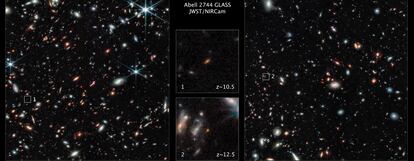The discovery of the oldest known black hole
The object already had the mass of several million suns when the universe was still in its infancy

After the Big Bang, everything happened very fast. Now, in the journal Nature, an international team of astronomers has just published their discovery of the oldest known black hole, which was already there over 13 billion years ago, only 400 million years after the Big Bang. In a very short time (on the cosmic scale), it accumulated the mass of several million suns. The discovery, made possible by the James Webb Space Telescope, tests the theories that attempt to explain how such objects form and grow.
The discovery was made at the center of galaxy GN-z11, which was discovered by the Hubble Space Telescope and was the oldest known galaxy until recently. Although it is 25 times smaller than the Milky Way and has only 1% of the stars, it was creating them 20 times faster. Its intense brightness suggested that a powerful black hole could be found inside it, as in galaxies like our own. Although these objects cannot be observed directly, the gas that accumulates in their vicinity heats up and emits ultraviolet rays that reveal their presence.
Roberto Maiolino, the lead author of the study and professor at the Kavli Institute of Cosmology in Cambridge, does not believe that these results will require new cosmological theories, no matter how surprising they may be. “At least, not yet,” he says. “The discovery of hypermassive black holes, with masses in excess of billions of solar masses, which were already there in the first billion years after the Big Bang, has been a puzzling result for 20 years,” he explains. The new observations identify the smaller progenitors of those objects that had grown at a rate that already seemed excessive.
One theory about the origin of black holes is that they appear when a star a hundred times larger than the sun exhausts its nuclear fuel and collapses under its own gravitational force. Then, feeding on their surroundings, they begin to accumulate mass, but, to reach the size of the object observed in the galaxy GN-z11 at the growth rate seen in nearby black holes, it would take billions of years. Yet the galaxy is only 400 million years old.
Among the models for making sense of these black holes, some experts say that, while they were born small, that early universe had much more gas available to fuel their growth and they could grow up to five times faster than previously thought possible. An alternative hypothesis posits that they also could have emerged as giants, the result of the gravitational collapse of primordial gas clouds. James Webb’s ability to transport us back to the universe’s infancy and discover more primordial black holes will serve to reconstruct the lineage of these influential cosmic monsters in the coming years.
“The presence of supermassive black holes in galaxies is very important, because we see that their properties are related to the galaxy’s properties,” says Michele Perna, the study’s co-author and a researcher at the Astrobiology Center in Madrid, Spain. “This is strange, because a black hole is very small compared to the size of the galaxy, like a euro compared to the size of the Earth, and its mass is also a fraction of that of the galaxy, like 1% or less,” he says. Despite these differences, there is a connection between the black hole’s activity and its galaxy, in how this comparatively small object determines the rate at which stars are born in the galaxy and when star formation stops.
In the case of GN-z11, astronomers believe that the black hole may be harming its development, because some of the gas that it voraciously consumes shoots out into the galaxy, like a hurricane, and may stop star formation. If that were to happen, it would rob the galaxy of life and spoil its food source.
Sign up for our weekly newsletter to get more English-language news coverage from EL PAÍS USA Edition
Tu suscripción se está usando en otro dispositivo
¿Quieres añadir otro usuario a tu suscripción?
Si continúas leyendo en este dispositivo, no se podrá leer en el otro.
FlechaTu suscripción se está usando en otro dispositivo y solo puedes acceder a EL PAÍS desde un dispositivo a la vez.
Si quieres compartir tu cuenta, cambia tu suscripción a la modalidad Premium, así podrás añadir otro usuario. Cada uno accederá con su propia cuenta de email, lo que os permitirá personalizar vuestra experiencia en EL PAÍS.
¿Tienes una suscripción de empresa? Accede aquí para contratar más cuentas.
En el caso de no saber quién está usando tu cuenta, te recomendamos cambiar tu contraseña aquí.
Si decides continuar compartiendo tu cuenta, este mensaje se mostrará en tu dispositivo y en el de la otra persona que está usando tu cuenta de forma indefinida, afectando a tu experiencia de lectura. Puedes consultar aquí los términos y condiciones de la suscripción digital.
More information
Oldest black hole discovered dating back to 470 million years after the Big Bang
Últimas noticias
Most viewed
- David King, chemist: ‘There are scientists studying how to cool the planet; nobody should stop these experiments from happening’
- Reinhard Genzel, Nobel laureate in physics: ‘One-minute videos will never give you the truth’
- Mexico completes its trade shift with the entry into force of tariffs on China and countries without trade agreements
- Oona Chaplin: ‘I told James Cameron that I was living in a treehouse and starting a permaculture project with a friend’
- Sinaloa Cartel war is taking its toll on Los Chapitos










































